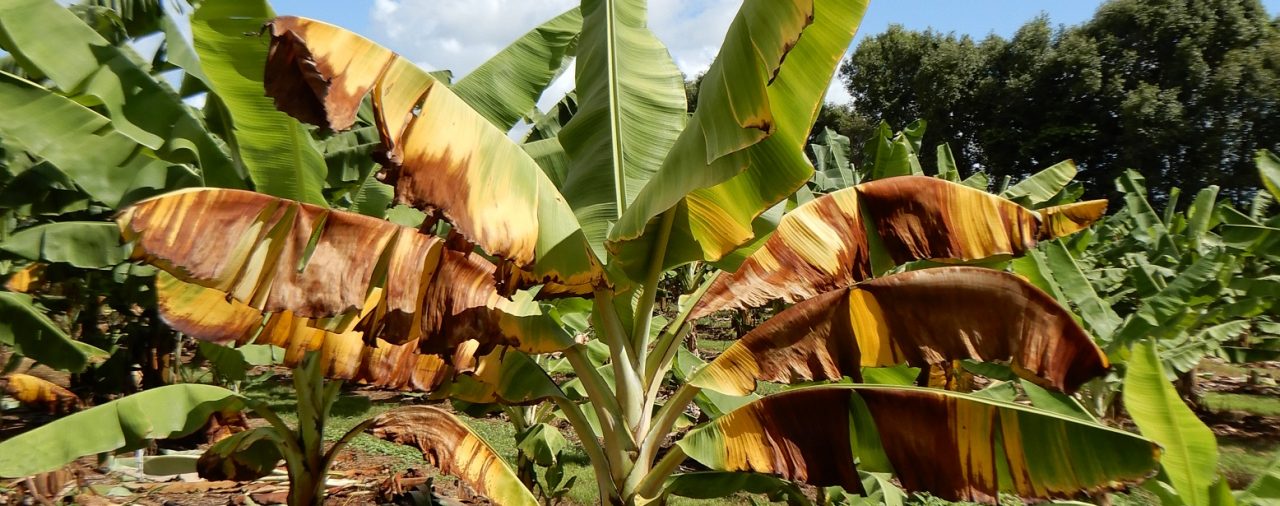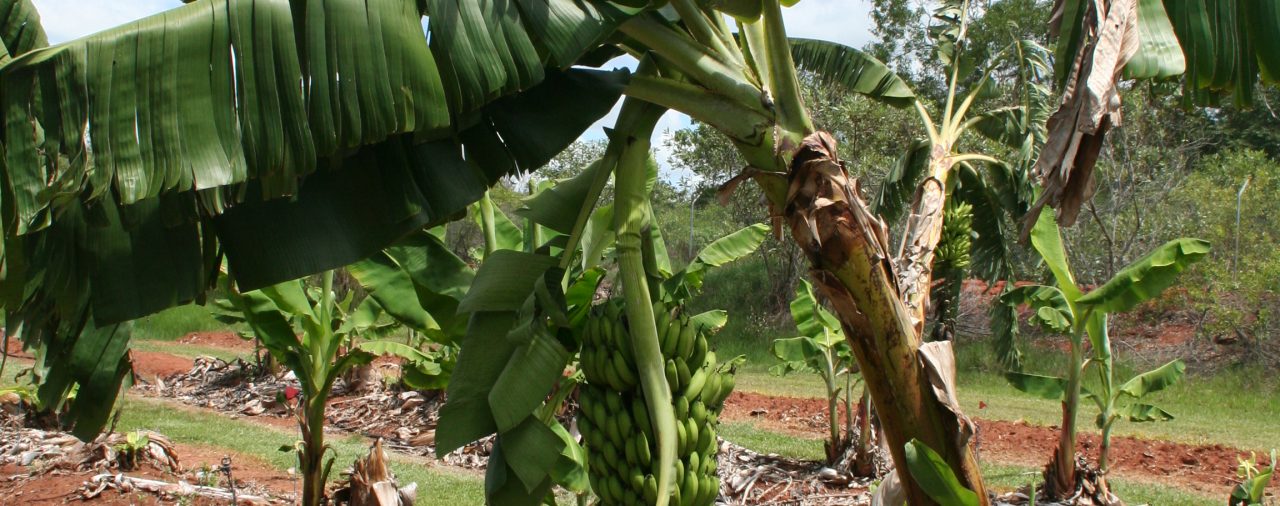Figure 1: Right, external symptoms of TR4 in an infected Cavendish plant. Note the leaf yellowing and leaf death. Left, internal symptoms caused by TR4. Note the reddish brown discoloration of water – conducting tissues.
Figure 2: Cavendish varieties showing resistance to TR4. From left, ratoon plants of CJ19, GCTCV 247 and GCTCV 215 (plant crop picture provided by Jeff Daniells).
By Sharl Mintoff (a), Tuan Vu Nguyenb (b), Sam Cullen (a), Chris Kelly (a) and Lucy Tran-Nguyen (a)
(a) Northern Territory Department of Primary Industry and Resources (b) Queensland Department of Agriculture and Fisheries
Planted in 2016 as part of the previous Banana Plant Protection Project (BA10020), the varietal screening trial at Coastal Plains Research Farm in the Northern Territory was completed in early 2018.
We collected data on the disease resistance of certain varieties to Fusarium oxysporum f. sp. cubense (Foc) Tropical race 4 (TR4), for the plant crop and a ratoon. The varieties comprised of several Cavendish lines (including Taiwanese GCTCV lines), FHIA hybrid and parental lines. We reported on the results from the plant crop in an earlier edition of Australian Bananas (April 2018). This article is an update on the performance of the first ratoon crop.
As a reminder, symptoms of Panama TR4 infected plants can include:
• Initial leaf yellowing of the oldest leaves, which leads to wilting and subsequent death of the leaves (Figure 1).
• Pseudostem splitting.
• A reddish-brown discolouration of the water-conducting tissues, evident when the pseudostem is cut through (Figure 1).
METHODS
The trial was planted in June 2016, with all plants artificially inoculated with TR4 colonised millet.
Once external symptoms become apparent in the susceptible Williams control plants, we conducted assessments fortnightly, noting the appearance of external disease symptoms and internal symptoms at plant death or harvest. Four reference varieties acted as controls, as their reactions to TR4 are well known: Williams – Very Susceptible; Formosana – Intermediate; FHIA-01 Goldfinger – Resistant; and FHIA-25 – Highly Resistant (deemed Highly Resistant in previous work).
As for the plant crop, we categorised the reactions to TR4 in this manner:
Resistant (R) – No disease symptoms were observed within the crop cycle.
Intermediate (I) – Majority of plants survived, with minimal plants showing symptoms or minor symptoms noted. With the appropriate crop, management or environment to lower the inoculum levels, these should be commercially viable.
Susceptible (S) – Majority of plants survived with more than 50% plants showing disease symptoms.
Very susceptible (VS) – Plants showed severe symptoms and more than >50% killed due to TR4 infection.
RESULTS
Resistant
Nine varieties remained resistant to TR4 in ratoon 1, with no external or internal symptoms observed.
The FHIA hybrids and parental lines, including FHIA-01, FHIA-02, FHIA-25, SH-3142, SH-3748, SH-3362 and SH-3362 Auto-tetraploid, demonstrated strong resistance to TR4. Pisang Gajih Merah and the Cavendish GCTCV 215 also showed resistance.
Intermediate
The varieties SH-3641, SH-3217, FHIA-18 and CJ19, which did not display symptoms of TR4 in the plant crop, all showed a small incidence of disease in the first ratoon crop, moving them into the Intermediate ranking. Whereas varieties GCTCV 247, SH-3436, Dwarf Nathan and FHIA-03 all retained their Intermediate rating in the first ratoon crop.
Very Susceptible
Eight varieties were deemed Very Susceptible.
The Intermediate control Formosana, which falls into the Intermediate category on the plant crop, succumbed to the disease and was rated as Very Susceptible in the 1st ratoon. The variety Dwarf Ducasse, previously classified as Susceptible, was rated as Very Susceptible in ratoon 1. The varieties Williams, DPM 25, Dwarf Parfitt off type, FHIA-26, SH-3656 and GCTCV 106 all remained Very Susceptible.
CONCLUSION
About two thirds of the varieties screened in the trial were intermediate in reaction or better in both plant and ratoon crops, with one third of the varieties tested remaining resistant into ratoon 1, which was very encouraging. Three of those varieties – CJ19, GCTCV 215 and 247 (Figure 2) – will be progressed to a pre-commercialisation phase to assess their prospects on commercial properties.
However, none of them yield as well over time compared to Williams grown in the absence of the TR4 pathogen. Additionally, some of these varieties were included for gamma irradiation as part of the mutagenesis program of the BA14014 project, in an attempt to improve their agronomic traits while maintaining TR4 resistance.






